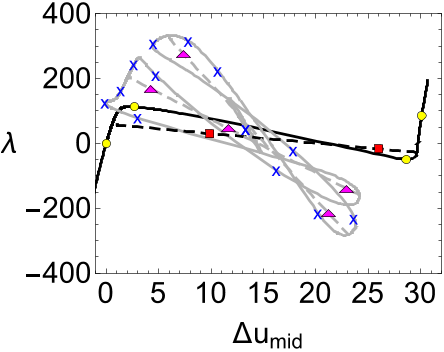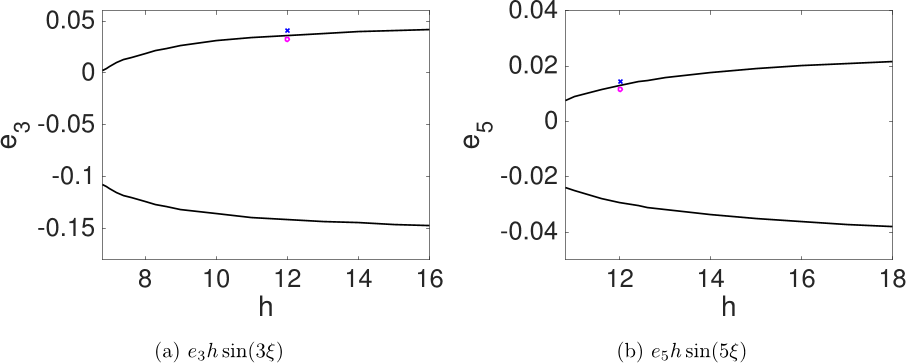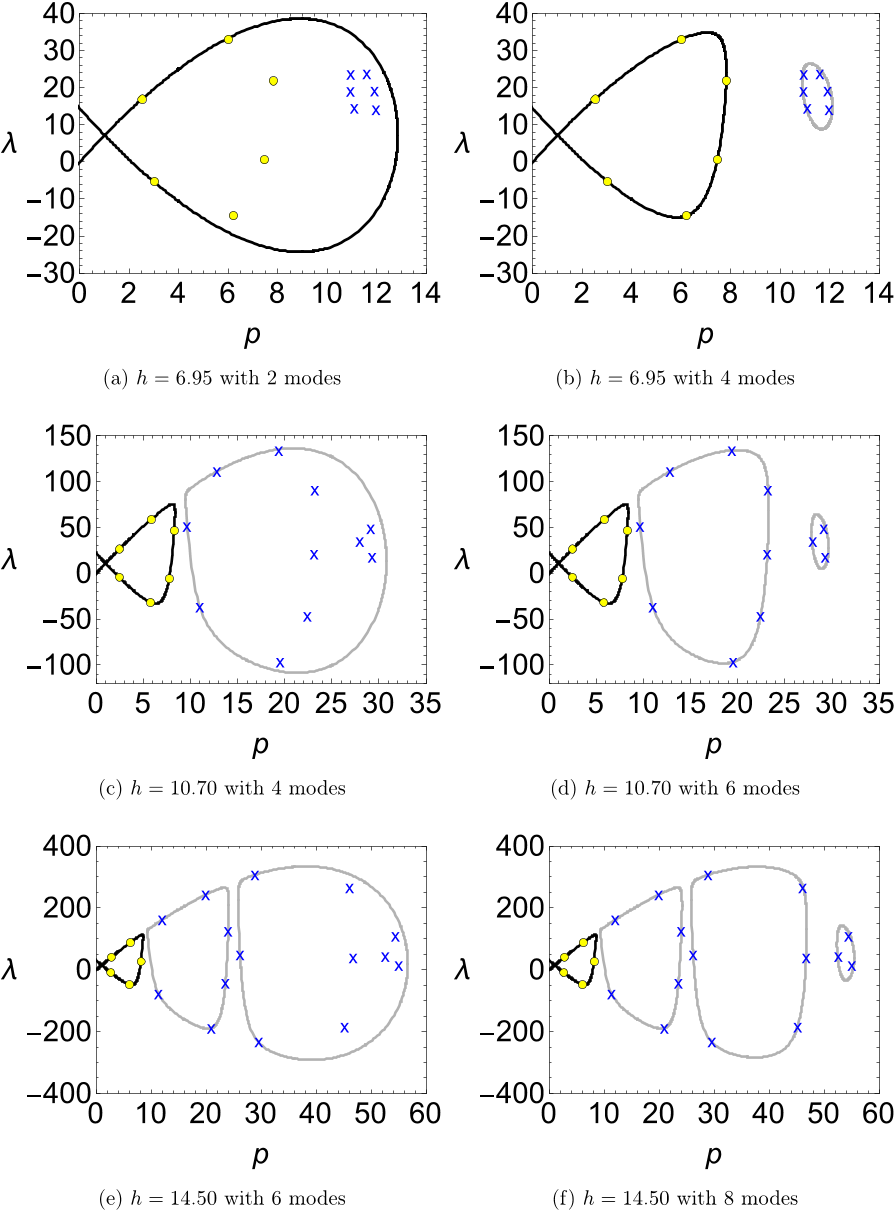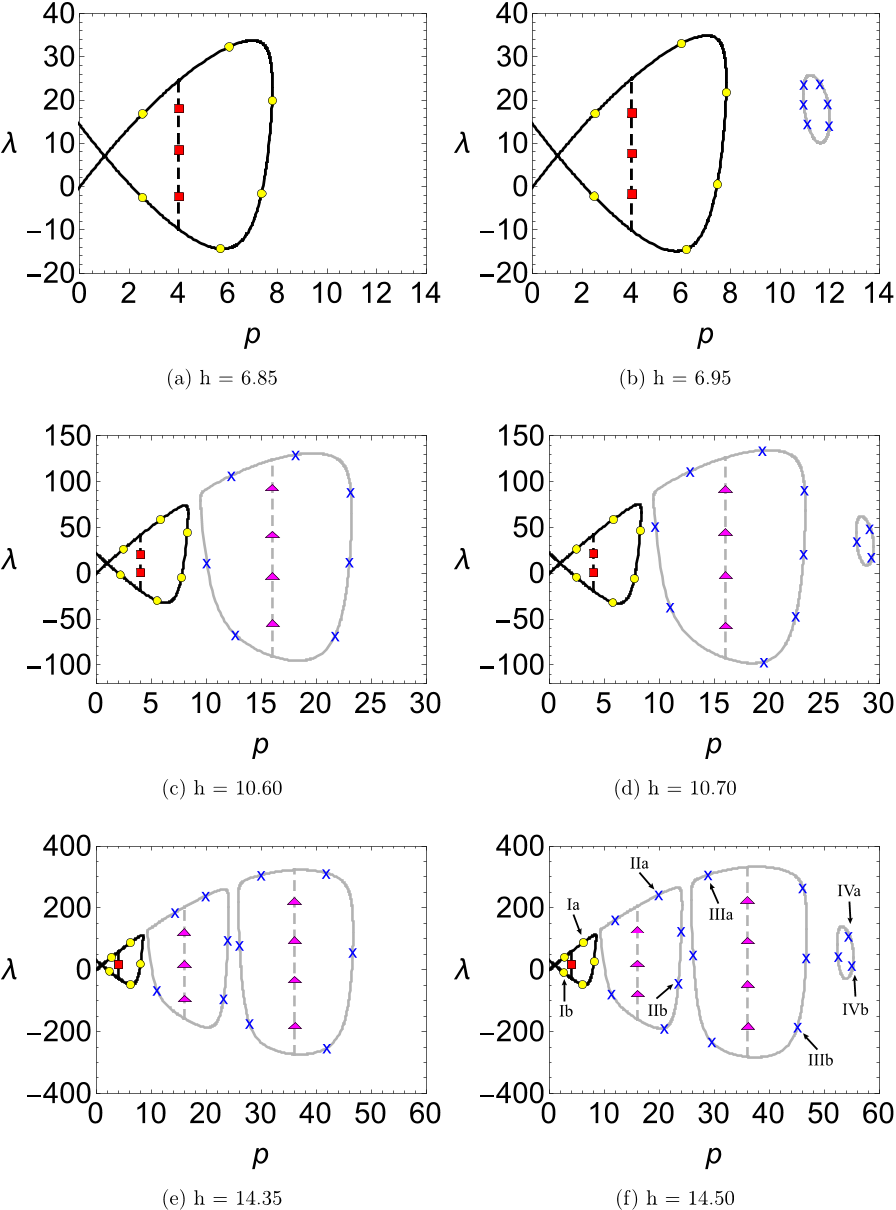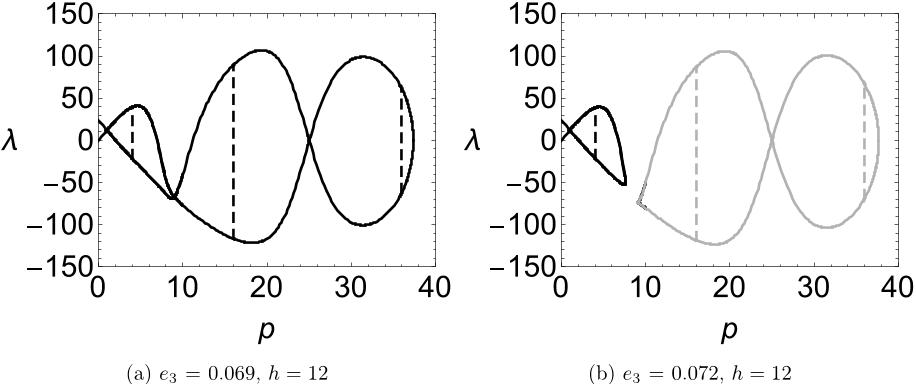
A general condition for the existence of unconnected
equilibria for symmetric arches
Yang Zhou, Ilinca Stanciulescu
∗
Rice University, Department of Civil and Environmental Engineering, Houston, TX, 77005, U.S.A
Abstract
This paper presents a semi-analytical study of unconnected equilibrium states for symmetric
curved beams. Using the Fourier series approximation, a general condition for the existence
of unconnected equilibria for symmetric shallow arches is derived for the first time. With
this derived condition, we can directly determine whether or not a shallow arch with specific
initial configuration and external load has remote unconnected equilibria. These unconnected
equilibria can not be obtained in experiments or nonlinear finite element simulations without
performing a proper perturbation first. The derived general condition is then applied to
curved beams with different initial shapes and external loads. It is found that initially
symmetric parabolic arches under a uniformly distributed vertical force can have multiple
groups of unconnected equilibria, depending on the initial rise of the structure. However,
small symmetric geometric deviations are required for parabolic arches under a central point
load, and half-sine arches under a central point load or a uniformly distributed load to have
unconnected equilibria. The validity of the analytical derivations of the nonlinear equilibrium
solutions and the general condition for the existence of unconnected equilibria are verified by
nonlinear finite element methods.
Keywords: Unconnected equilibrium states, A general condition, Symmetric curved beams,
Post-buckling responses
1. Introduction
Curved beams have been studied extensively due to their rich nonlinear structural be-
havior and broad applications in aerospace, civil and mechanical engineering. When these
∗
Corresponding author. Tel.: +1713 348 4704; fax: +1713 348 5268.
Email address: ilinca.s@rice.edu (Ilinca Stanciulescu)
Preprint submitted to Elsevier November 18, 2017

arches are loaded transversely, they can jump between coexisting equilibrium configurations,
phenomenon accompanied by rapid curvature reversals. This phenomenon is often referred
to as snap-through buckling and it greatly exacerbates fatigue failure.
Motivated by the goal of avoiding snap-through, a great portion of studies in the early
literature focused on calculating the buckling loads of shallow arches with different geome-
try, boundary and loading conditions. One of the earliest work was included in [1], where
Timoshenko used the first symmetric mode to obtain the solutions for a half-sine arch under
a half-sine load. This study provided some guidance for analyzing snap-through but failed to
consider possible bifurcated branches that involve higher order modes. Following this work,
Fung and Kaplan [2] used few sine terms to obtain the stability boundaries of sine arches
with several different types of transverse loads. Instead of using Fourier series, Schreyer and
Masur [3] directly solved the differential equations analytically and made a special effort to
differentiate symmetric and asymmetric snap-through. These pioneering studies have been
extended by many researchers to examine the influence of elastic boundary constraints on
critical equilibrium states [4–9], to characterize the sensitivity of buckling loads to geometric
and load imperfections [10–17], to derive exact solutions for critical loads without truncat-
ing the Fourier series [18, 19], to incorporate thermal effects in nonlinear buckling analyses
[20–23], and to study the effects of pre-buckling deformations, initial shapes and loading on
the nonlinear stability responses [23–29]. In these investigations, the snap-through buckling
loads were obtained but few efforts were made to characterize the post-buckling responses.
Despite inducing fatigue, snap-through has recently been utilized in developing vibratory
energy harvesters [30, 31], switches [32, 33], sensors [34] and non-volatile memories [35]. In
these applications, the curved beams are designed to undergo snap-through and to work in
the post-buckling region. Therefore, only determining snap-through buckling loads is not
sufficient and it is also necessary to gain insights into the post-snap responses. In fact,
recent studies have continued to reveal new and interesting post-snap responses. Pi and
Bradford [36–38] found that curved beams with unequal boundary conditions may have four
limit points and looping equilibrium states in the post-buckling responses. Moghaddasie and
Stanciluescu [39] identified that more pairs of critical points and more complex post-snap
behaviors can exist for shallow arches in thermal environments. Similar phenomena were also
observed by Hung and Chen [40] for buckled beams on elastic foundations. In addition to the
2

identification of connected complex looping equilibria, Harvey and Virgin [41] demonstrated
that remote equilibria exist for curved beams under an off-center point load in physical
experiments by manually perturbing the structure to a remote configuration. The current
authors Zhou et al. [42] showed that shallow arches with asymmetric geometric imperfections
can have remote unconnected “hidden” equilibria, which are difficult to obtain numerically if
a prior knowledge of these “hidden” equilibria is not available. It was also identified in [42]
that asymmetric geometric imperfections make the bifurcated paths disappear and equilibria
split around these secondary paths.
In the current paper, we find that initially symmetric arches may also have unconnected
“hidden” equilibria, which is not as initially expected. Unlike arches with asymmetric geo-
metric imperfections, it is in general difficult to tell when symmetric arches have unconnected
equilibria. Here, a general condition for the existence of unconnected equilibria is derived
for shallow symmetric arches. We apply this general condition on perfect parabolic, half-sine
arches and these arches with small symmetric geometric deviations when they are subjected
to uniformly distributed load and point load in the middle and verify the validity of the gen-
eral condition by comparing the equilibrium states of the structures with parameters below
and above the general condition. It is found that the existence of unconnected equilibria is
very sensitive to the arches’ initial configurations and to the type of external load that they
are subjected to. This work can also help to guide the exploration of the “hidden” equilibria
in numerical and physical experiments.
Remote unconnected equilibria may not affect the static buckling loads of the structures.
However, they can influence the dynamic responses of the structures. Under dynamic pertur-
bations, these structures may jump to remote unconnected configurations. Pi and Bradford
[38] identified that it is crucial to identify all coexisting equilibria of the structures to cor-
rectly determine the dynamic snap-through buckling loads. More recently, Wiebe and Virgin
[43] demonstrated that the presence and location of unstable equilibria can also have a great
impact on the long-term recurrent behavior of a dynamic system. We conjecture that the
identification of remote unconnected equilibria may provide useful information for the design
of devices that take advantage of dynamic snap-through and work under post-snap regions
such as energy harvesters, switches, sensors and non-volatile memories [30–35].
3

2. Governing equations
Using the Fourier series and following [42], the dimensionless algebraic equilibrium equa-
tions of shallow arches under transverse loads (Fig. 1) can be written as
(α
n
− β
n
)n
4
− pn
2
α
n
+ q
n
= 0, n = 1, 2, ..., k, (1)
u(ξ)
u
ξ
π
0
q
(ξ)
Figure 1: A shallow arch under a transverse load.
Here, α
n
represent the mode coefficients of the deformed configurations u(ξ) =
k
P
n=1
α
n
sin(nξ),
β
n
are the mode coefficients of the initial configuration u
0
(ξ) =
k
P
n=1
β
n
sin(nξ), q
n
denote
the mode coefficients of the non-dimensional external load q and can be calculated from
q
n
= (2/π)
R
π
0
q sin (nξ) dξ, k is the number of Fourier Sine terms included, and p is the
dimensionless axial force that can be calculated from
p =
k
X
i=1
i
2
(β
2
i
− α
2
i
)
4
. (2)
A brief description of the procedure involved in deriving Eq. (1) is included in the Appendix
and more details can be found in [42].
2.1. Equilibrium states
Let the external load q(ξ) be expressed as q(ξ) = λq
0
(ξ), where q
0
(ξ) is a reference function
that can be chosen as needed and λ is the loading parameter. It can then be found that the
load coefficients q
n
have a linear relationship with the loading parameter λ for an arbitrary
4

transverse load. The linear relationship is q
n
= γ
n
λ, and γ
n
will be referred as the reference
loading coefficients that can be calculated from
γ
n
=
2
π
Z
π
0
q
0
(ξ) sin(nξ)dξ (3)
Substituting the load coefficients q
n
= γ
n
λ into Eq. (1), the non-dimensional algebraic
equilibrium equation for shallow arches under an arbitrary vertical load can be obtained
(α
n
− β
n
)n
4
− pn
2
α
n
+ λγ
n
= 0, n = 1, 2, ..., k, (4)
The deformation mode coefficients α
n
can then be calculated as
α
n
=
n
4
β
n
− λγ
n
n
2
(n
2
− p)
, n = 1, 2, ..., k (5)
With these deformation mode coefficients α
n
and Eq. (2), we can find that the loading
parameter λ satisfies the following quadratic equation
Aλ
2
+ Bλ + C + 4p = 0 (6)
For a given arch shape and loading case, A, B and C are functions of the axial load p and
are defined as follows:
A(p) =
k
P
n=1
γ
2
n
n
2
(n
2
− p)
2
B(p) =
k
P
n=1
−2n
2
γ
n
β
n
(n
2
− p)
2
C(p) = 4p +
k
P
n=1
n
6
β
2
n
(n
2
− p)
2
− n
2
β
2
n
(7)
Substituting the mode coefficients α
n
into the deformed configuration u(ξ), the vertical
displacement field ∆u(ξ) can be obtained as
∆u = − (u (ξ) − u
0
(ξ))
=
k
X
n=1
β
n
sin(nξ) −
k
X
n=1
n
2
β
n
(n
2
− p)
sin(nξ) −
k
X
n=1
γ
n
λ
n
2
(n
2
− p)
sin(nξ) (8)
Setting ξ = π/2, the displacement at the midspan can then be derived as
∆u
mid
= D(p)λ + F (p) (9)
5
